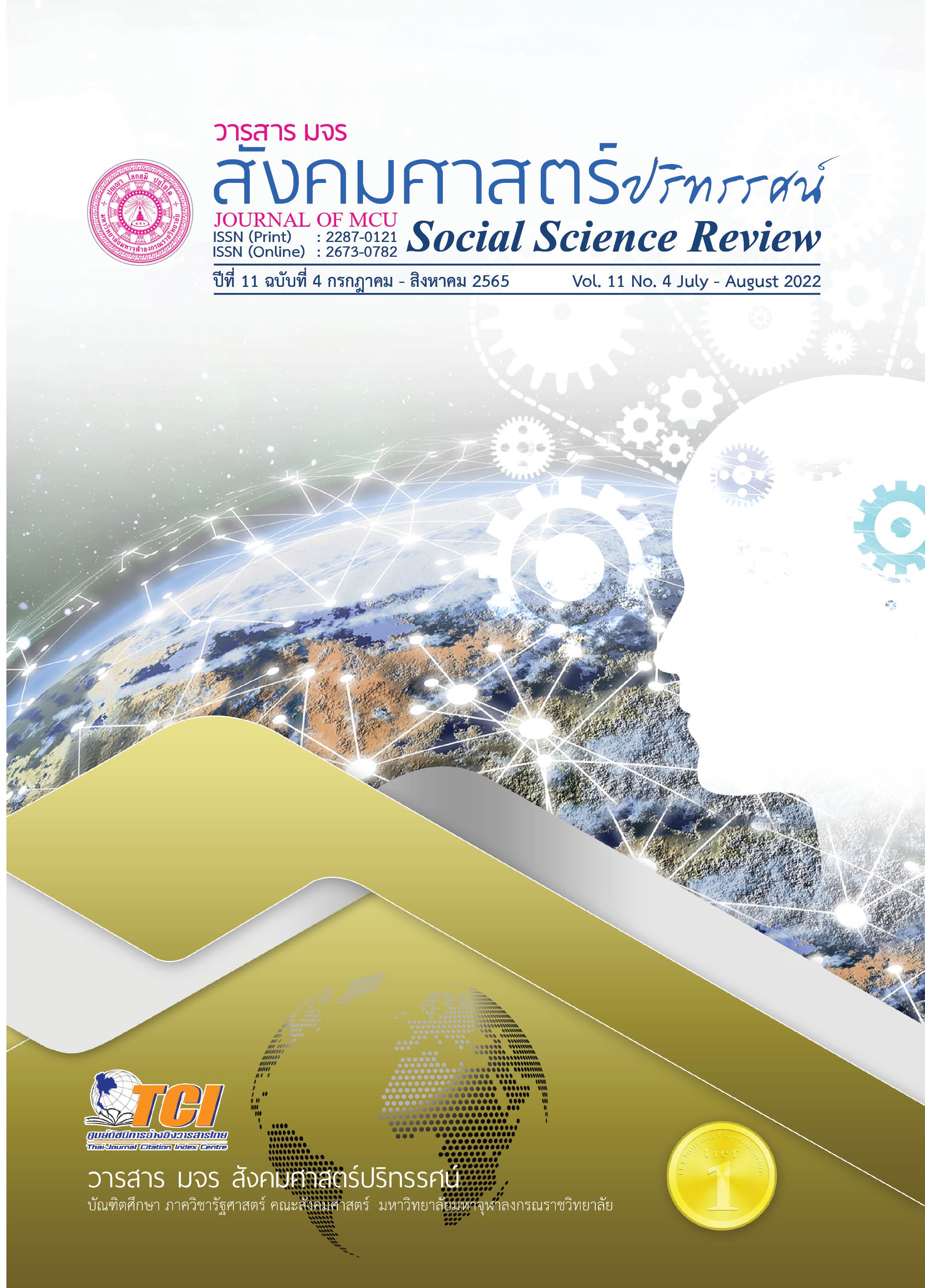ระดับความอยู่ดีมีสุขและตัวพยากรณ์ความอยู่ดีมีสุขของประชาชน อำเภอบางไทร จังหวัดพระนครศรีอยุธยา
คำสำคัญ:
ความอยู่ดีมีสุข, บางไทร, อยุธยา, ตัวพยากรณ์, ประชาชนบทคัดย่อ
การวิจัยนี้มีวัตถุประสงค์เพื่อศึกษาระดับความอยู่ดีมีสุข ศึกษาตัวแปรที่สามารถพยากรณ์ความอยู่ดีมีสุข และเพื่อสร้างสมการพยากรณ์ความอยู่ดีมีสุขของประชาชน อำเภอบางไทร จังหวัดพระนครศรีอยุธยา กลุ่มประชากรคือ ประชาชนในทุกตำบลของอำเภอบางไทร จังหวัดพระนครศรีอยุธยา จำนวน 48,037 คน ขนาดตัวอย่างเท่ากับ 400 คน เก็บรวบรวมข้อมูลด้วยแบบสอบถาม สถิติที่ใช้ในการวิเคราะห์ข้อมูลได้แก่ ความถี่ ร้อยละ ค่าเฉลี่ย ส่วนเบี่ยงเบนมาตรฐาน และการวิเคราะห์การถดถอยพหุคูณตามวิธีแบบรายขั้นตอน
ผลการวิจัยพบว่า ประชาชนในอำเภอบางไทร จังหวัดพระนครศรีอยุธยามีความอยู่ดีมีสุขโดยรวมในระดับมาก ทั้งนี้ระดับความอยู่ดีมีสุขในด้านสุขภาพอนามัยอยู่ในระดับมากที่สุด รองลงมาคือด้านชีวิตครอบครัวอยู่ในระดับมาก และด้านที่น้อยที่สุดคือด้านชีวิตการทำงานอยู่ในระดับปานกลาง ตัวแปรที่สามารถพยากรณ์ความอยู่ดีมีสุขมี 7 ตัวแปรได้แก่ สุขภาพอนามัย ความรู้ ชีวิตการทำงาน รายได้และการกระจายรายได้ ชีวิตครอบครัว สภาพแวดล้อมในการดำรงชีวิต และการบริหารจัดการที่ดีของรัฐ ประสิทธิภาพในการพยากรณ์เท่ากับ 84.2%
เอกสารอ้างอิง
ไชยฤทธิ์ อนุชิตวรวงศ์. (2559). แนวคิดความอยู่ดีมีสุขของไทย. สืบค้น 20 สิงหาคม 2564, จาก https://shorturl.asia/hbsY8
ทวีชัย เชสูงเนิน และปิยธิดา คูหิรัญญรัตน์. (2554). ความอยู่ดีมีสุขและปัจจัยที่เกี่ยวข้องของผู้สูงอายุที่เป็นสมาชิกสมาคมข้าราชการ บำเหน็จบำนาญและผู้สูงอายุ จังหวัดขอนแก่น. ขอนแก่น: มหาวิทยาลัยขอนแก่น.
ประสพศรี รักความสุข และคณะ. (2550). ความสุขในสายตาของชุมชน. วารสารเศรษฐกิจและสังคม, 44(1), 69-74.
เริงชัย ตันสุชาติ และธรรญชนก คำแก้ว. (2551). ดัชนีวัดความสุขและความอยู่ดีมีสุขของสมาชิกชุมชนในมูลนิธิโครงการหลวง (รายงานผลการวิจัย). เชียงใหม่: มหาวิทยาลัยแม่โจ้.
วิทมา ธรรมเจริญ และคณะ. (2561). ความอยู่ดีมีสุขของผู้สูงอายุ: กรณีศึกษา ตำบลสองพี่น้อง อำเภอท่าใหม่ จังหวัดจันทบุรี. วารสารวิชาการมหาวิทยาลัยหอการค้าไทย, 38(1), 36-53.
ศรีสวรินทร์ สินชัย. (2561). เปรียบเทียบความอยู่ดีมีสุขของครอบครัวระหว่างครอบครัวเดี่ยวและครอบครัวขยายในตำบลบ้านสวน อำเภอเมือง จังหวัดชลบุรี (วิทยานิพนธ์พยาบาลศาสตรมหาบัณฑิต สาขาวิชาการพยาบาลเวชปฏิบัติครอบครัว). ชลบุรี: มหาวิทยาลัยบูรพา.
สุรัตน์สวดี แซ่แต้ และคณะ. (2550). ภาวะอยู่ดีมีสุขของประชาชนในตำบลคูเต่า อำเภอหาดใหญ่ จังหวัดสงขลา. สงขลา: มหาวิทยาลัยราชภัฏสงขลา.
สำนักงานสภาพัฒนาการเศรษฐกิจและสังคมแห่งชาติ. (2547). กรอบแนวคิด หลักเกณฑ์ และวิธีการวัดความอยู่ดีมีสุขของคนไทย. สืบค้น 9 กรกฎาคม 2564, จากhttps://www.nesdc.go.th/article_attach/article_file_20191018102412.pdf
สำนักงานสถิติแห่งชาติ. (2564). สำมะโน/สำรวจ. สืบค้น 12 กรกฎาคม 2564, จากhttp://www.nso.go.th/sites/2014/Pages/home.aspx
สภาพัฒนาการเศรษฐกิจและสังคมแห่งชาติ. (2562). กรอบแนวคิดความอยู่ดีมีสุข. สืบค้น 13 กรกฎาคม 2564, จากhttps://shorturl.asia/6Vp1e
Streiner, D.L. & Norman, G.R. (1995). Health Measurement Scales: A practical guide to their development and use (2nd ed). Oxford: Oxford University Press.
ดาวน์โหลด
เผยแพร่แล้ว
รูปแบบการอ้างอิง
ฉบับ
ประเภทบทความ
สัญญาอนุญาต
ลิขสิทธิ์ (c) 2022 วารสาร มจร สังคมศาสตร์ปริทรรศน์

อนุญาตภายใต้เงื่อนไข Creative Commons Attribution-NonCommercial-NoDerivatives 4.0 International License.
เพื่อให้เป็นไปตามกฎหมายลิขสิทธิ์ ผู้นิพนธ์ทุกท่านต้องลงลายมือชื่อในแบบฟอร์มใบมอบลิขสิทธิ์บทความให้แก่วารสารฯ พร้อมกับบทความต้นฉบับที่ได้แก้ไขครั้งสุดท้าย นอกจากนี้ ผู้นิพนธ์ทุกท่านต้องยืนยันว่าบทความต้นฉบับที่ส่งมาตีพิมพ์นั้น ได้ส่งมาตีพิมพ์เฉพาะในวารสาร มจร สังคมศาสตร์ปริทรรศน์ เพียงแห่งเดียวเท่านั้น หากมีการใช้ภาพหรือตารางหรือเนื้อหาอื่นๆ ของผู้นิพนธ์อื่นที่ปรากฏในสิ่งตีพิมพ์อื่นมาแล้ว ผู้นิพนธ์ต้องขออนุญาตเจ้าของลิขสิทธิ์ก่อน พร้อมทั้งแสดงหนังสือที่ได้รับการยินยอมต่อบรรณาธิการ ก่อนที่บทความจะได้รับการตีพิมพ์ หากไม่เป็นไปตามข้อกำหนดเบื้องต้น ทางวารสารจะถอดบทความของท่านออกโดยไม่มีข้อยกเว้นใดๆ ทั้งสิ้น





